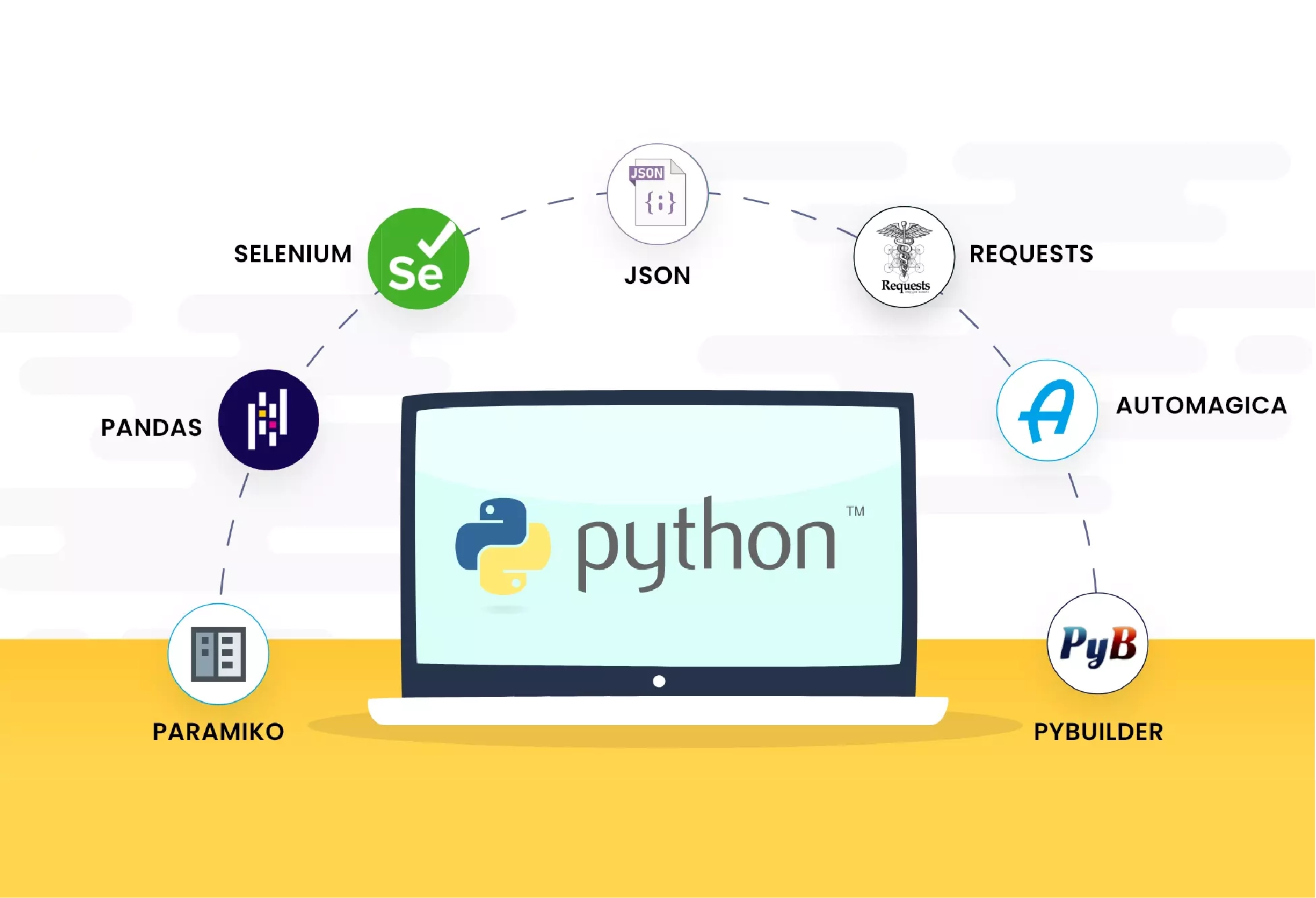Python’s simplicity, readability, and comprehensive library ecosystem have established it as a top automation force. From businesses seeking to automate operations to solo developers aiming to streamline tedious tasks, Python provides a robust foundation of tools, thus being ranked as the top 1 most used programming language according to Tiobe index..
It enables companies to create scalable automation pipelines and empowers individuals to automate their everyday workflows. In this article, we present six actual Python automation examples that illustrate how the language saves time, reduces errors, and reduces operational costs.

Why Use Python for Automation?
Before diving into the real examples, it’s worth knowing why Python is usually the first choice for automation projects. Because of its easy syntax and humongous package repository, Python lowers the barrier for building automated systems.
It can be used on all major operating systems, including Windows, Linux, and macOS, which makes it ideal for cross-platform automation. And most importantly, it gets along well with tools and platforms, ranging from Excel and databases to REST APIs and web browsers.
Simple syntax, massive library ecosystem
Python makes it possible to do a lot with very few lines of code. Libraries like pandas, requests, and smtplib eliminate the need to reimplement the wheel, and tools like pip and conda render dependency management easy. This excess cuts development time for automation pipelines by several orders of magnitude.
OS compatibility (Windows, Linux, macOS)
Automation scripts scale typically have to run in numerous environments. Python’s built-in cross-platform ability ensures that a script, when written, can be installed anywhere feasibly with minimal adjustment.
Integration with tools like Excel, APIs, web browsers
Covering integration with Excel spreadsheets, controlling headless browsers, and more, Python’s flexibility is its core value. This capability is the basis for most of the Python automation scripts examples given below.
File and Folder Automation
One of the simplest automation wins is file management and organizing. Businesses are dealing with hundreds or thousands of files, such as receipts, images, and CSVs, that need to be renamed, copied, or organized. Python is equipped with all the built-in functions in other modules, such as shutil and pathlib, to automate these processes with ease.
Use case: Rename files in bulk, organize directories
Consider a marketing department that’s getting hundreds of product photos from suppliers with unpredictable naming conventions. Using a Python script, one can rename these files according to a standard naming convention, organize them into folder categories, and store older versions automatically.
Tools: os, shutil, pathlib
One example script would use os.listdir() to iterate over files, shutil.move() to reorder them, and pathlib to construct folder structures dynamically or verify that they exist. Scripts often get invoked via cron jobs or Windows Task Scheduler to execute on a recurring schedule.
Code snippet: batch rename or folder structure creation
import os
from pathlib import Path
folder = Path(‘/images/uploads’)
for i, file in enumerate(folder.iterdir()):
if file.suffix == ‘.jpg’:
new_name = folder / f”product_{i+1}.jpg”
file.rename(new_name)
Web Scraping and Data Collection
Data collection from websites manually is both time-consuming and error-prone. Python makes it possible to scrape efficiently as well as collect data in an organized manner through libraries like requests, BeautifulSoup, Selenium, and Scrapy. This is handy when monitoring prices, gathering public data, or aggregating competitor data.
Use case: Monitor competitor prices, extract data from websites
A company can automate competitor price monitoring. A Python script can scrape online shops every day, store the information in a database, and send alerts if it’s necessary to modify pricing strategies. This gives companies a considerable benefit when implementing dynamic pricing policies.
Tools: requests, BeautifulSoup, Selenium, Scrapy
requests, and BeautifulSoup work great for static pages, but Selenium for JavaScript pages. Scrapy provides a robust framework for building crawlers that scale, featuring high-level features such as retries and asynchronous processing.
Considerations: robots.txt, rate limits, legality
Be respectful of site’s terms of service and web scraping ethics. Always check robots.txt, apply rate limiting, and refrain from scraping either personal data or copyrighted material.
Automating Reports and Spreadsheets
Reporting is a routine job in the majority of industries. The most effective Python automation project example is the automation of generating spreadsheets, charts, and PDF summaries. Python is able to fetch information from APIs or databases, process it, and present it in a comprehensible format.
Use case: Generate weekly Excel or PDF reports
A sales department may automate weekly performance dashboards generation with pandas and xlsxwriter, such as charts, conditional formatting, and emailing.
Tools: pandas, openpyxl, xlsxwriter, matplotlib
These instruments provide the building blocks for data manipulation (pandas), Excel output (openpyxl, xlsxwriter), and visualization (matplotlib). Scripts can be scheduled to run automatically, eliminating manual effort.
Example: auto-generate charts from sales data
import pandas as pd
import matplotlib.pyplot as plt
data = pd.read_csv(‘sales.csv’)
data.groupby(‘region’).sum()[‘revenue’].plot(kind=’bar’)
plt.savefig(‘weekly_sales.png’)

Email and Notification Automation
Tasks of communication are an area where Python can bring valuable benefits. Anything, from sending template emails to notifying users of system status, can be automated by Python.
Use case: Send alerts or newsletters
A Python script can pull user data from a CRM, generate a customized message, and dispatch it using SMTP or a third-party service like SendGrid. It’s beneficial for marketing campaigns or system alerts.
Tools: smtplib, email, third-party APIs like SendGrid
A Python script can retrieve user data from a CRM, create a custom message, and send the message using SMTP or a third-party mailer, such as SendGrid. It is convenient for marketing campaigns or system notifications.
Sample script: send templated emails from a CSV list
import smtplib
import csv
with open(‘contacts.csv’) as f:
reader = csv.DictReader(f)
for row in reader:
message = f”Subject: Welcome\n\nHi {row[‘name’]}, welcome aboard!”
smtp.sendmail(‘you@example.com’, row[’email’], message)
API Interaction and Integration
APIs have now become a normal part of the business process. Python facilitates easy consumption, manipulation, and automation of API interactions, whether it is internal, public, or third-party.
Use case: Automate tasks via external APIs (e.g., Slack, Google Sheets, Trello)
Imagine a customer support team receiving a daily Slack report of tickets open from their helpdesk tool. Python can invoke the API, transform the data, and publish it to a Slack channel.
Tools: requests, httpx, google-api-python-client
Python has strong HTTP clients like requests and httpx, and most platforms maintain official Python SDKs. If you’re syncing data or building bots, Python is ideal for APIs. For small companies using APIs, turning to Python software development for startups can be beneficial.
Example: Post a daily message to a Slack channel
import requests
url = “https://slack.com/api/chat.postMessage”
payload = {“channel”: “#support”, “text”: “Daily summary complete.”}
headers = {“Authorization”: “Bearer xoxb-…”}
requests.post(url, json=payload, headers=headers)
Business Process Automation
For companies that need to automate complex internal processes, Python offers real ROI. Python software and scripts can automate HR and logistics tasks, swapping human interventions for real-time data streams.
Real-world examples:
Companies across industries leverage Python to automate critical business processes. For instance, Spotify has used Python to streamline internal onboarding workflows, from account creation to welcome communication. Stripe automates finance operations like invoice generation and reconciliation using Python-based scripts.
In retail, Walmart employs Python to synchronize inventory data between its e-commerce platform and backend systems, ensuring stock accuracy across channels. Python automation is applied across diverse domains globally, helping businesses of all scales save time, reduce human error, and enable smarter operations.
Getting Started: Tools and Tips
To begin building Python automation projects, you will need a good environment and deployment strategy. Intensive editors like VS Code and PyCharm provide robust debugging and testing capabilities.
Scheduling can be facilitated using cron (Linux), Task Scheduler (Windows), or apscheduler for scheduling within the app. Scripts are deployable once tested, locally, containerized with Docker, or as serverless functions with AWS Lambda or Google Cloud Functions.
Conclusion
Python is not just for developers; it is a productivity tool for anyone. These Python automation project examples demonstrate that simple-to-write code can create dramatic efficiency gains. From renaming files to generating reports to invoking APIs, automation delivers long-term return on investment with zero future cost.
In a world of increasing speed and accuracy, Python lets you accomplish more with less effort, fewer mistakes, and measurable results.
